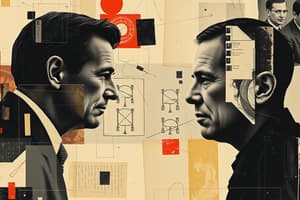Podcast
Questions and Answers
What primarily distinguishes task conflict from relationship conflict?
What primarily distinguishes task conflict from relationship conflict?
- Task conflict centers on understanding positions, while relationship conflict focuses on personal characteristics. (correct)
- Task conflict involves strong negative emotions, while relationship conflict does not.
- Task conflict arises from a lack of respect, while relationship conflict arises from respect.
- Task conflict leads to harmful outcomes, whereas relationship conflict has constructive outcomes.
What is the significance of perception in the conflict process?
What is the significance of perception in the conflict process?
- Perception shapes how conflicts are experienced and acted upon. (correct)
- Perception has no impact on conflict outcomes.
- Conflict arises solely from factual discrepancies.
- Perception eliminates the need for resolution.
Which of the following best describes relationship conflict?
Which of the following best describes relationship conflict?
- Encourages emotional detachment from disagreements.
- Involves respect and understanding of different viewpoints.
- Concentrates on attacking the worth of others. (correct)
- Focuses on collaborative problem-solving.
How do structural sources of conflict contribute to disagreements?
How do structural sources of conflict contribute to disagreements?
What outcome is generally associated with constructive task conflict?
What outcome is generally associated with constructive task conflict?
What is the first step in the negotiation process?
What is the first step in the negotiation process?
What is a characteristic of superordinate goals?
What is a characteristic of superordinate goals?
What does BATNA stand for in negotiation?
What does BATNA stand for in negotiation?
What is described as the zone between each party’s resistance point in negotiations?
What is described as the zone between each party’s resistance point in negotiations?
What approach involves reducing differences in values and attitudes among parties?
What approach involves reducing differences in values and attitudes among parties?
What is the primary purpose of mediation in third-party conflict resolution?
What is the primary purpose of mediation in third-party conflict resolution?
In which situation is negotiating generally considered easier?
In which situation is negotiating generally considered easier?
What best describes integrative bargaining?
What best describes integrative bargaining?
Which step in the negotiation process follows the definition of ground rules?
Which step in the negotiation process follows the definition of ground rules?
Which type of third-party intervention has high control over the final decision but low control over the process?
Which type of third-party intervention has high control over the final decision but low control over the process?
What characteristic of the physical setting can affect the negotiation process?
What characteristic of the physical setting can affect the negotiation process?
What should individuals know about their BATNA prior to negotiating?
What should individuals know about their BATNA prior to negotiating?
How can communication help in conflict management?
How can communication help in conflict management?
What is an outcome of clarifying rules and procedures in conflict situations?
What is an outcome of clarifying rules and procedures in conflict situations?
Which factor can make negotiators more competitive and reluctant to make concessions?
Which factor can make negotiators more competitive and reluctant to make concessions?
What is a method to reduce interdependence among conflicting parties?
What is a method to reduce interdependence among conflicting parties?
What is the primary goal when managing team conflicts?
What is the primary goal when managing team conflicts?
Which condition is likely to minimize relationship conflict during task conflict?
Which condition is likely to minimize relationship conflict during task conflict?
What is a negative outcome of relationship conflict within a team?
What is a negative outcome of relationship conflict within a team?
Which source of conflict is characterized by competing interests between parties with different goals?
Which source of conflict is characterized by competing interests between parties with different goals?
When is the forcing conflict-handling style most appropriate?
When is the forcing conflict-handling style most appropriate?
What is a key drawback of the compromising conflict-handling style?
What is a key drawback of the compromising conflict-handling style?
Which type of conflict handling is best when one party holds significantly more power?
Which type of conflict handling is best when one party holds significantly more power?
What factor can escalate conflicts due to misunderstandings between parties?
What factor can escalate conflicts due to misunderstandings between parties?
What is a disadvantage of the avoiding conflict-handling style?
What is a disadvantage of the avoiding conflict-handling style?
Under what condition is the problem-solving conflict handling style preferable?
Under what condition is the problem-solving conflict handling style preferable?
Flashcards
Conflict
Conflict
A process where one party feels their interests are being threatened or negatively impacted by another party.
Task Conflict (Constructive)
Task Conflict (Constructive)
Conflict focused on the task at hand, where people respect different viewpoints and try to understand each other's logic.
Relationship Conflict
Relationship Conflict
Conflict focused on personal characteristics or traits, leading to undermining and negativity.
Conflict is based on Perception
Conflict is based on Perception
Signup and view all the flashcards
Conflict Process Model
Conflict Process Model
Signup and view all the flashcards
Conflict: Perception and Interests
Conflict: Perception and Interests
Signup and view all the flashcards
Positive Outcomes of Conflict
Positive Outcomes of Conflict
Signup and view all the flashcards
Negative Outcomes of Conflict
Negative Outcomes of Conflict
Signup and view all the flashcards
Managing Conflict: The Balancing Act
Managing Conflict: The Balancing Act
Signup and view all the flashcards
Minimizing Relationship Conflict
Minimizing Relationship Conflict
Signup and view all the flashcards
Sources of Conflict
Sources of Conflict
Signup and view all the flashcards
Conflict and Interdependence
Conflict and Interdependence
Signup and view all the flashcards
Conflict and Scarce Resources
Conflict and Scarce Resources
Signup and view all the flashcards
Emphasize Superordinate Goals
Emphasize Superordinate Goals
Signup and view all the flashcards
Reduce Differentiation
Reduce Differentiation
Signup and view all the flashcards
Improve Communication
Improve Communication
Signup and view all the flashcards
Reduce Interdependence
Reduce Interdependence
Signup and view all the flashcards
Increase Resources
Increase Resources
Signup and view all the flashcards
Clarify Rules and Procedures
Clarify Rules and Procedures
Signup and view all the flashcards
Distributive Negotiation
Distributive Negotiation
Signup and view all the flashcards
Integrative Negotiation
Integrative Negotiation
Signup and view all the flashcards
What is BATNA?
What is BATNA?
Signup and view all the flashcards
What is the Bargaining Zone?
What is the Bargaining Zone?
Signup and view all the flashcards
What is the first step in the Negotiation Process?
What is the first step in the Negotiation Process?
Signup and view all the flashcards
What is defining ground rules?
What is defining ground rules?
Signup and view all the flashcards
Why is clarification and justification important in negotiation?
Why is clarification and justification important in negotiation?
Signup and view all the flashcards
What does bargaining and problem solving involve in negotiation?
What does bargaining and problem solving involve in negotiation?
Signup and view all the flashcards
What is closure and implementation in negotiation?
What is closure and implementation in negotiation?
Signup and view all the flashcards
What can situational influences affect in a negotiation?
What can situational influences affect in a negotiation?
Signup and view all the flashcards
Study Notes
Chapter 11: Conflicts and Negotiations in the Workplace
-
Workplace conflict occurs when one party perceives that their interests are opposed or negatively affected by another party.
-
Conflict can be categorized as task conflict (constructive) or relationship conflict (destructive). Task conflict focuses on the issue at hand, while relationship conflict focuses on personal characteristics.
Learning Objectives
- Defining conflict and different types of conflicts
- Examining structural sources of conflict
- Analyzing conflict handling contingencies
- Understanding structural approaches to conflict management
- Identifying various types of third-party intervention
- Mastering conflict resolution through negotiation
Conflict
- Conflict is a process where one party believes their interests are opposed by another.
Emerging Views: Task vs. Relationship Conflict
- Task Conflict (constructive): Parties concentrate on the issue, respect differing viewpoints, and attempt to understand each other's logic and assumptions.
- Relationship Conflict (destructive): Focuses on personal characteristics instead of issues, aims to undermine the worth or competence of the other party, and is accompanied by strong negative emotions.
The Conflict Process Model
- The conflict process encompasses the stages from the source of conflict to conflict outcomes, with an escalation cycle in between.
- Sources of Conflict: Origins of the difficulties.
- Conflict Perceptions and Emotions: How individuals perceive and feel about the conflict.
- Manifest Conflict: The visible expressions of the conflict.
- Conflict Outcomes: Positive or negative consequences of the conflict process.
The Relationship Between Conflict and Outcomes
- A moderate level of conflict can lead to positive organizational outcomes like more creative ideas and improved responsiveness.
- High levels of conflict often result in negative outcomes like unproductive time wasted, tension, job dissatisfaction, and turnover.
Is Conflict Good or Bad?
- Negative Outcomes:
- Wasted time, energy, and resources
- Less information sharing and reduced productivity
- Increased organizational politics
- More job dissatisfaction, turnover, and stress
- Weakened team cohesion (especially internal conflict)
- Positive Outcomes:
- Fuller debate of important decisions
- More creative ideas
- Enhanced responsiveness to the external environment
- Strengthened team cohesion when conflict arises with other teams.
Minimizing Relationship Conflict
- Encourage task conflict and minimize relationship conflict in the workplace.
- Relationship conflict often occurs when engaging in task conflict.
- Three factors that minimize relationship conflict during constructive task conflict:
- High emotional intelligence
- Highly cohesive teams
- Supportive team norms
Sources of Conflicts
- Incompatible goals: When one party's goals interfere with another's.
- Differentiation: Different values, attitudes, and beliefs (e.g., cultural differences, generational gaps).
- Interdependence: The degree of interaction between parties, often leading to conflict when increased.
- Scarce Resources: When resources (e.g., budget, time, equipment) are limited.
- Ambiguous Rules: Vague or unclear rules and procedures can lead to conflict.
- Poor Communication: Lack of clarity, trust, and active listening can lead to misunderstandings and disagreements.
Structural Sources of Conflict
- Incompatible Goals: One party's goals conflict with another party's goals and/or ways of achieving them.
- Differentiation: Differences in values, beliefs, culture, and experiences can lead to conflict.
- Interdependence: Increased interaction between individuals/departments/teams can increase the likelihood of conflict.
- Scarce Resources: Competition for scarce resources (e.g., budget, time, equipment) is a common source of conflict.
- Ambiguous Rules: Unclear rules or procedures can contribute to conflict.
- Communication Problems: Problems in communication or poor communication can result in conflict.
Five Conflict Handling Styles
- The Styles are visualised on a graph, measuring assertiveness and cooperation.
- Positions each handling style in a 2x2 matrix as follows
- Forcing (Win-Lose): High assertiveness, Low Cooperation
- Problem Solving (Win-Win): High assertiveness, High Cooperation
- Compromising: Medium assertiveness, Medium Cooperation
- Yielding (Lose-Win): Low assertiveness, High Cooperation
- Avoiding: Low assertiveness, Low Cooperation
Conflict Handling Contingencies
- Problem Solving: Best when interests are not perfectly opposing, and parties have trust.
- Forcing: Best when a quick decision is necessary and there is a conviction about one's position.
- Avoiding: Best when conflict is emotionally charged, with potential high costs to resolving.
- Yielding: Best when the other party has significantly more power, the issue is less critical to you, or your position's value or logic is less convincing.
- Compromising: Best when parties have equal power, a solution is needed quickly.
Structural Approaches to Conflict Management
- Emphasize superordinate goals: Setting common goals that require joint efforts.
- Reduce differentiation: Reducing differences in values, attitudes, and experiences, potentially through job reassignments.
- Improve communication: Improving communication & mutual understanding, using tools like the contact hypothesis or Johari window.
Types of Third-Party Intervention
- Arbitration: A neutral third party makes a binding decision to resolve the conflict.
- Inquisition: A third party actively questions and directs the conflicting parties (high control).
- Mediation: A neutral third party helps facilitate communication, but the decision is made by the parties involved.
How to Negotiate
-
Five key steps: Strategy development, establishing ground rules, clarifying positions, bargaining and problem-solving, and closure and implementation.
-
Understand BATNA (best alternative to a negotiated agreement).
Preparing to Negotiate
- Developing goals and understanding needs.
- Understanding your BATNA (best alternative to a negotiated agreement).
- Identifying your power.
- Identifying the bargaining zone (the zone between the resistance points of the parties involved).
Situational Influences on Negotiations
- Location
- Physical setting
- Audience
Additional Information/Videos
- Videos on negotiation techniques/strategies might be linked and mentioned as relevant learning resources.
Studying That Suits You
Use AI to generate personalized quizzes and flashcards to suit your learning preferences.




